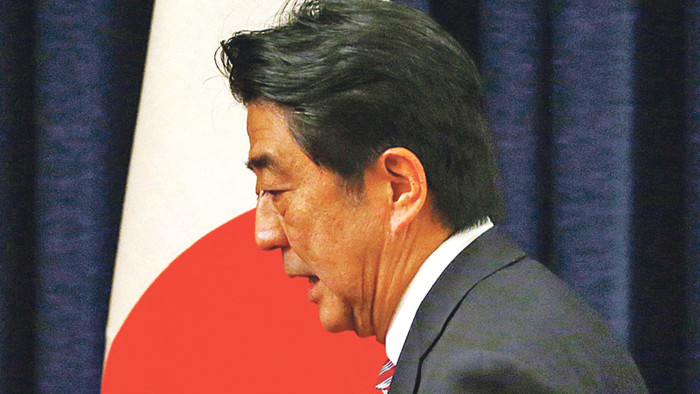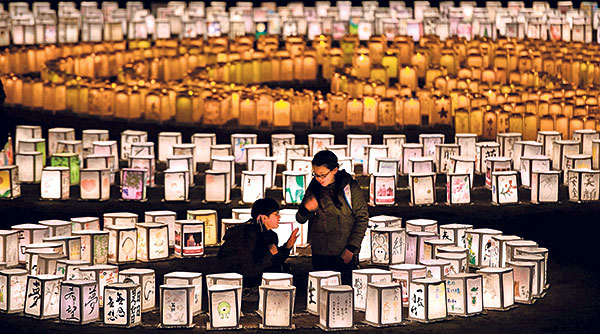World watches Japan and waits for outcome of Abenomics experiment

Roula Khalaf, Editor of the FT, selects her favourite stories in this weekly newsletter.
We live in an era of radical economic policy experiments. The US Federal Reserve has bought trillions of dollars in assets. Europe’s single currency is suffering a trial by fire. But none of these policy adventures has less precedent, or higher stakes, than the events unfolding in Japan today.
When Shinzo Abe, Japan’s prime minister, came to power in 2012 he launched a stimulus aimed at ending 20 years of entrenched deflation. He did so in a country with vast public debts and a declining population. These circumstances have never been encountered before — let alone overcome.
His so-called “Abenomics” policies will therefore provide a road map — good or bad — to European countries where similar problems are brewing. Abenomics consists of “three arrows”: a massive monetary stimulus by the Bank of Japan, a fiscal boost by the government that has already turned into a fiscal squeeze, and structural reforms to boost long-term growth.
It will have big effects on Japan’s material prosperity and on global financial markets. But more than that, the results of Abenomics will determine what kind of country Japan is to be.
Success in reigniting growth and dealing with Japan’s public debt would allow a happier, more optimistic country to emerge — one with the confidence to handle an unstable region. Failure, on the other hand, would mean a more inward-looking Japan — still wealthy, of course, and full of creativity — but resentful of its own decline and the rise of its Chinese neighbour.
“I propose that the greatest issue here is the fact that the Japanese people have been robbed of their confidence,” Mr Abe said in his first policy speech to parliament after a landslide victory in snap elections held last December.
So far, the results of Mr Abe’s policies have encouraged the sceptics. Growth last year was slightly negative after a big consumption tax rise; prices are set to fall for much of this year as the effects of lower oil prices feed through. But many outside observers still think the policy is basically working.
“In essence, the Japanese recovery is going right even if it is not going well,” says Adam Posen, president of the Peterson Institute for International Economics in Washington, DC, in a recent assessment of Mr Abe’s programme.
Joshua Hausman, assistant professor of public policy at the University of Michigan, says of the Bank of Japan’s action: “I still think it’s the right policy”. Last year, Mr Hausman wrote about Abenomics for the Brookings Institution: “You’re in a bad situation, you have a policy that might make things much better and it doesn’t have obvious costs, so why not try it?”

What is now clear is that the mere fact of the Bank of Japan’s regime change — adopting a 2 per cent inflation target and launching a huge programme of bond purchases to back it up — has not ignited inflation.
But Abenomics is on track to deliver price rises the old-fashioned way: by running demand in the economy ahead of supply. The unemployment rate is down to 3.6 per cent and companies are struggling to find workers. Though the process is painfully slow, the conditions are ripe for wages to pick up, creating a virtuous circle of further inflation.

Perhaps the closest analogy to what Bank of Japan governor Haruhiko Kuroda is trying to do — create expectations of inflation where there were none — is former Fed chairman Paul Volcker’s problem in the 1980s, when he had to extinguish expectations that US prices would rise rapidly every year.
Mr Volcker did it with a big recession. It may be that Mr Kuroda needs to push Japan into a boom to get the same result, and he seems willing to oblige. “In order to escape from deflationary equilibrium, tremendous velocity is needed, just like when a spacecraft moves away from Earth’s strong gravitation,” the BoJ governor said in a recent speech. “It requires greater power than that of a satellite that moves in a stable orbit.”

Progress on tackling Japan’s budget deficit has stalled after the postponement of another consumption tax rise until 2017.
Opinion is split between those such as Mr Posen, who thought the delay unwise, and economists such as Paul Krugman, who want to get inflation up before applying any fiscal brakes. Either way, it raises the stakes for a long-term fiscal strategy that the government has promised by this summer.
That leaves the third arrow of structural reform. There is disappointment about specific items, such as a proposal for special economic zones, which have gone nowhere. But there is change.

Nearly 1m women have joined the labour force in the past couple of years. Corporate governance reform is placing real pressure on companies to distribute cash. The Trans-Pacific Partnership trade deal looks more likely than ever to pass in the months ahead.
Much will depend on how Mr Abe uses the mandate of his recent re-election. His first act was a modest, but highly symbolic, reform to the agricultural sector.

Abenomics leaves foes with nowhere to turn: lacking an alternative plan to revive Japan’s economy, opponents must sell the politics of fear, not hope, leaving the prime minister scope to push for tough reforms.
A possible banana skin — one that Mr Abe has always seemed eager to slip on — is foreign policy, with China and South Korea poised to take offence at any perceived lack of contrition on this year’s 70th anniversary of defeat in the second world war.
The prime minister is also keen to make progress on his long-time goal of reform to the war-renouncing constitution, but in general he has kept a disciplined focus on the economy.
“Now is the time. Through our efforts, Japan can achieve growth once again. We can shine once more on the world stage. We are regaining our confidence,” said Mr Abe in his policy speech.
We will soon know whether or not he is right.
Comments